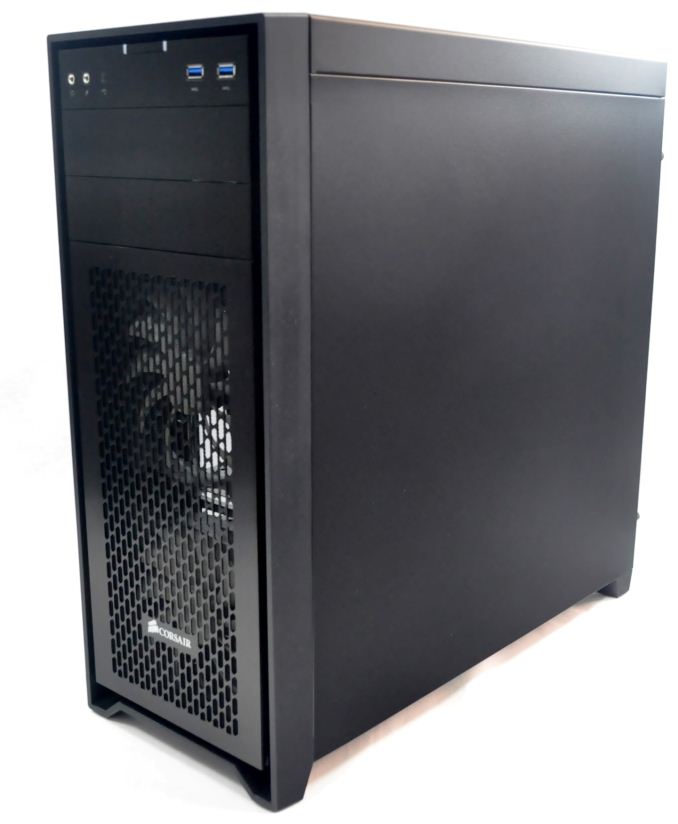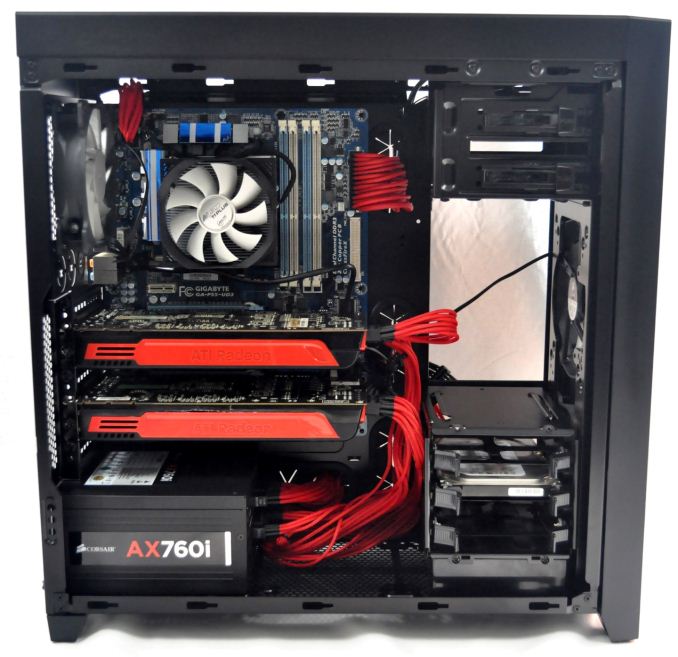Corsair Obsidian 450D Case Review
by E. Fylladitakis on April 4, 2014 6:00 AM EST- Posted in
- Cases/Cooling/PSUs
- Corsair
- mid-tower
- Case
Final Words
With the Obsidian 450D, Corsair attempted to fill the gap between the Micro-ATX 350D and the very large 750D of the same series with a mid-tower case of normal proportions. Yes, they already have half a dozen mid-tower cases available, such as the Graphite 230T and the Carbide 300R, but only the 650D / 550D are part of the Obsidian series and they have been engineered with entirely different target groups in mind. The Obsidian 450D is a normal sized mid-tower case designed to deliver flexibility and cooling for a reasonable retail price. Considering the variety of cooling options that may be applied and the additional flexibility that the removable drive cage offers, the Obsidian 450D does very well in terms of versatility, within the boundaries of a mid-tower design of course.
The thermal performance of the Obsidian 450D definitely is to be reckoned. Even with the slow-spinning stock fans, the heavily perforated chassis of the Obsidian 450D allows heat to escape towards virtually all directions if required. As such, the thermal performance of the Obsidian 450D is unusually high for a mid-tower ATX design. On the other hand, these many openings have the exact opposite effect when it comes to noise suppression; they do nothing to stop noise from exiting the chassis.
The stock cooling of the Obsidian 450D is very good in terms of acoustics performance, with the fans being only slightly audible even while running at maximum speed; however, although the noise figures are very low for a case with so many openings, even with the fans running at maximum speed, the noise of everything installed inside the Obsidian 450D (e.g. GPUs, CPU coolers, etc.) will not be damped in the slightest. Corsair obviously did not design Obsidian 450D with minimal noise operation in mind; it wouldn't make much sense to do so either, as they already had the Obsidian 550D available for that purpose.
In terms of design, the Obsidian series consists of Corsair's most serious and elegant products. They have not been created so as to stand out via an aggressive appearance or strong lighting; the Obsidian series cases lure the attention of spectators through their clean, refined design. The post-minimalistic design of the 450D is undoubtedly a perfect match for the Obsidian series. Uniqueness however is an entirely different story; the Obsidian 450D is essentially a larger 350D or smaller 750D, as all three of these cases share the same design. Even the cubic 250D and the massive 900D share a similar core design, with the distinguishable dissimilarities being due to their much different shape. If the 450D had no perforated front intake cover, it could be easily mistaken for a 350D, even though the latter is significantly shorter.
The MSRP of $119 is reasonable for an Obsidian series case, especially considering that the similarly sized 650D retails for nearly twice the price. However, there are multitudes of similarly sized and less expensive products available, some of which offer the Obsidian 450D strong competition. Even Corsair's own products, such as the Carbide 500R and 300R, are possible opponents for the Obsidian 450D, as they too offer good cooling options and versatility. We however believe that the strongest feature of the Obsidian 450D is its graceful, clean appearance, which will surely attract a significant number of consumers all by itself.
In summary, the Obsidian 450D delivers great cooling performance and a clean aesthetic at a moderately high price. Those who have eyed the Obsidian 350D in the past and wanted something a bit larger (but not as large as the 650D) will be pleased with what it offers. Corsair continues to make cases that are easy to work with and have all the necessary features, and the 450D is no exception. While it's not the best fit for a low-noise solution, enthusiasts and gamers will have plenty to work with.












36 Comments
View All Comments
ekagori - Sunday, April 6, 2014 - link
I personally like the way E has been reviewing his cases, using stock cooling in a case and components gives you a good idea how well a system will handle such constant loads at its most basic cooling levels. People complain about variance in components, well guess what, if a case can handle 850W of constant heat with stock cooling, it can handle a system with a 4930k, R9 290x, 3 HDDs that produces 550W. Oh but you wish to add another R9 290x for CF and now produces 800W? Well guess what, it can still handle it. Oh but what if I add a Noctua NH-D14 cooler to my rig...Hmmm... it will still handle it... What about if I add a few extra fans....Hmmm...yeah still good.The point of the review is for us to know if a system can handle a "normal" 450W load or an "extreme" 850W load on stock cooling regardless of what components you are using. Of course temperatures will be lower if you use better fans, better cpu cooler, water cooling for gpus, etc. But they will never be any higher or worse than at stock.
If people have such a problem with this methodology and want to have "useful" reviews based on individual components they may want to purchase than you should start spending countless of your hours to make your own reviews, let's see how far you get before you decide that reviewing thousands of different combinations is just plain useless and way too time consuming.
Sushisamurai - Monday, April 7, 2014 - link
^ this. The current methodology is better than the previous method due to the standardized input of heat. It eliminates most variables due to component differences.Additional comparisons between stock and added/differing components would be rendered pointless, as the stock would be a reference point and the components would therefore be akin to a margin of error. The problem lies in the variability of different setups/components giving far too many margin's of error. Which one would you use?
Say @stock @current methodology Case X dissipates @42 degrees @850W.
Components A test Case X @44 degrees @850W
Components A test change front fan B Case X @46 degrees @850W
Components A test change back fan B Case X @41 degrees @850W
Now what happens when you start mixing top/front/back fans and components? You're essentially testing components in a set Case, with new data points that are not comparable to other reviews. Or, you're essentially testing components to build the best setup in terms of heat-noise-temperature for that set case (common, Anandtech can't do all the work for you)
Hrel - Friday, April 11, 2014 - link
This case gets no quieter than 32db? That's absurdly loud.JimmyJame - Thursday, October 16, 2014 - link
Extremely disappointed in this product yes it might only be a small part however I have paid top dollar for this product. Opened up the box unpacked everything then come to find that the plastic foot at the back of the case has been broken. Plastic crap!phorgan1 - Saturday, February 6, 2016 - link
Corsair's web site says it supports eATX but you don't list that. Since I'm looking at a GIGABYTE GA-Z170X-SOC FORCE which is an eATX board, it sure would be nice to have confirmation.SCyn - Tuesday, January 16, 2018 - link
How do i undervolt the fans? help